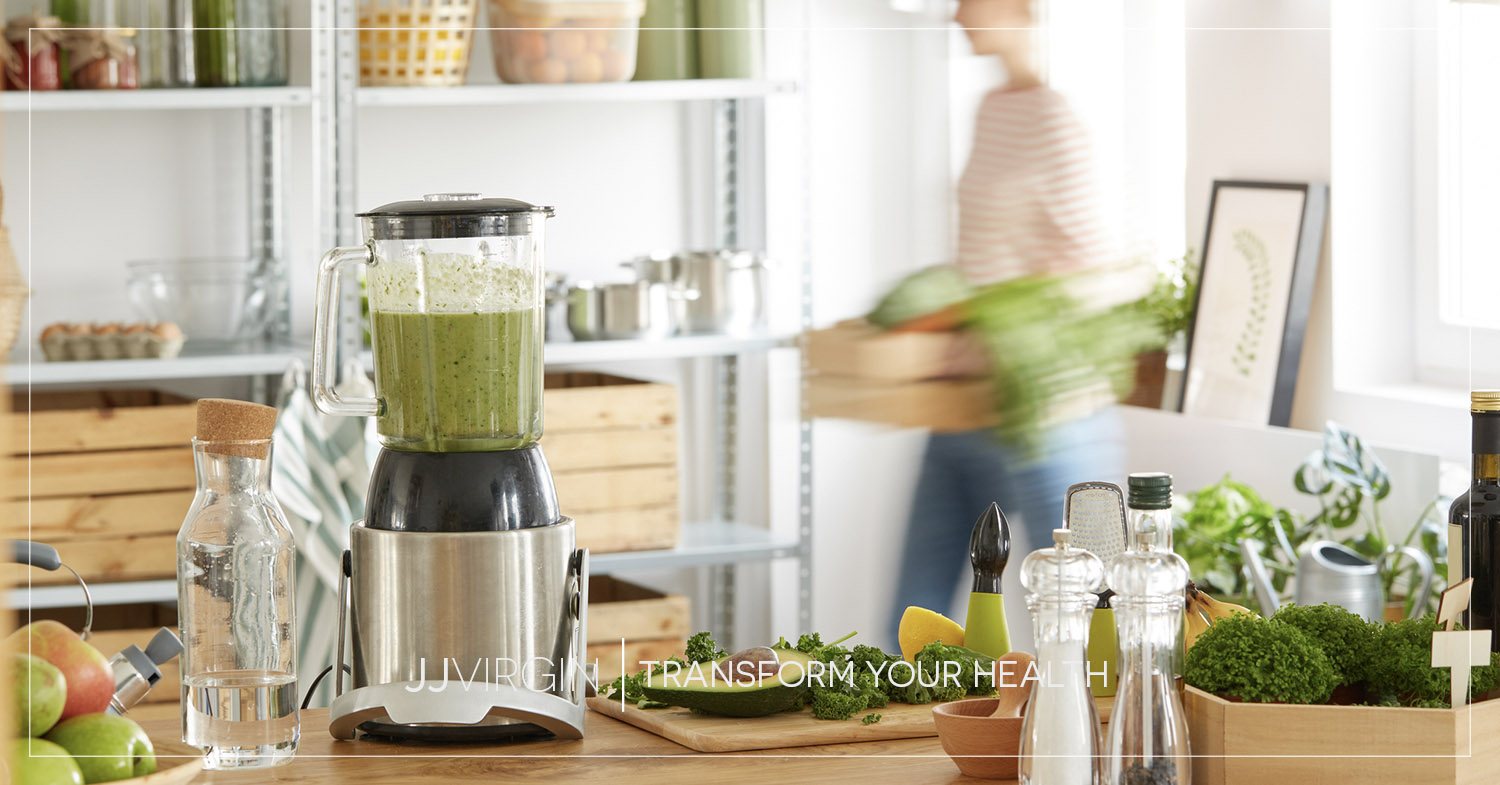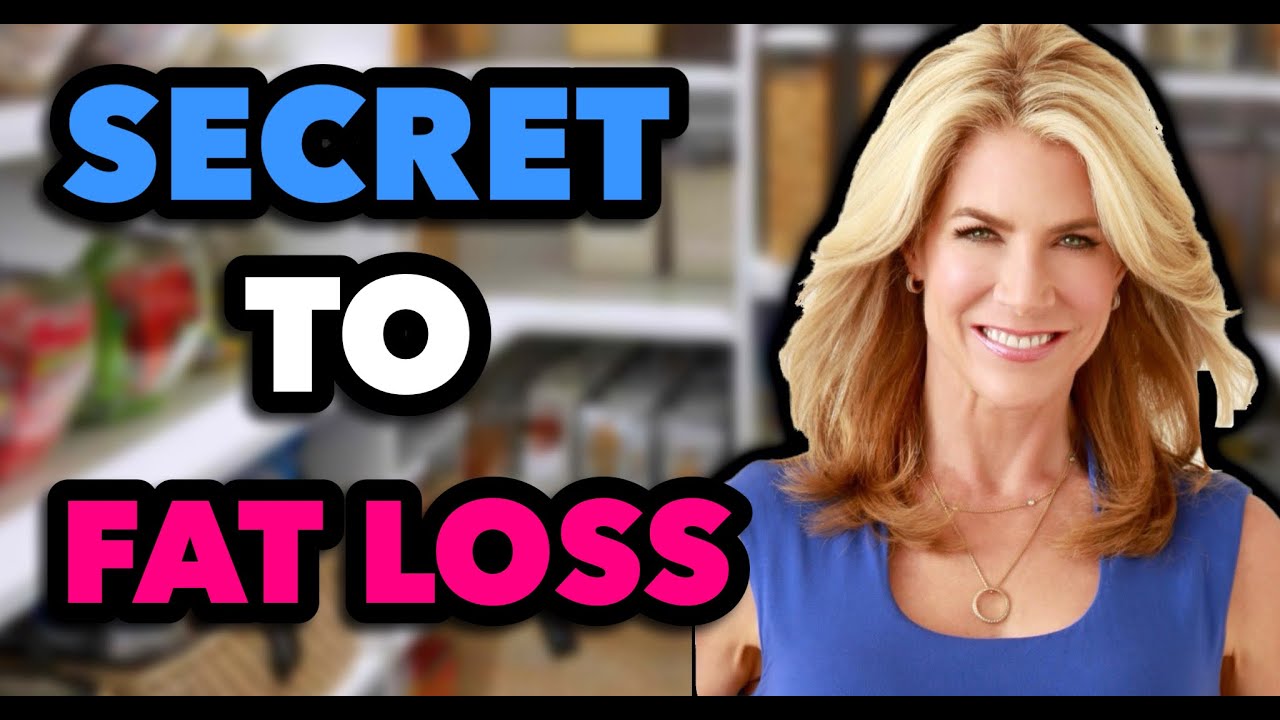Planning ahead can take away the frustration or confusion that may arise when you’re eating healthy.
Whether you’re following the Sugar Impact Diet or the Virgin Diet, you can prepare your kitchen in advance to stay on track, avoid temptation… and be the best fat burner.
Brownies, fudge + more… without the guilt? Yes, please! You’ll find 15 fab recipes in my Sweet Treats Recipe Guide to satisfy your sweet tooth, without the added sugars and other problem ingredients. Get your FREE guide here.
Keep the enemy out of the house
If you can’t resist ice cream, don’t buy it! If chips are your downfall, steer clear of the snack aisle while in the grocery store. You’re less likely to fall prey to trigger foods if they’re not in your home, desk, glove compartment, or wherever else you stash them. Even healthy foods, if you have a tendency to overeat them, can quickly become unhealthy.
Invite the good guys in
It’s not enough just to toss out the bad guys! You also need to keep your fridge and pantry stocked with smart options.
Having nutritious ingredients on hand helps you create healthy meals without having to worry or check ingredient labels. Plus, doing so makes choosing the right foods practically automatic.
And if you’re not sure what to add to your shopping cart, don’t worry – I’ve got you covered!
Here are the top kitchen staples that will help you build a balanced meal every time…
1. Non-Dairy Milk and Yogurt
Dairy is one of the most common sources of food sensitivities, triggering symptoms like gas and bloating, inflammation, weight gain, and skin issues. The good news is that there’s plenty of healthy, tasty alternatives to cow’s milk and yogurt that won’t leave you feeling miserable!
Here are some of my favorites…
When making a protein smoothie, opt for non-dairy beverages in a carton such as:
- Unsweetened coconut milk
- Unsweetened nut milk, like almond or macadamia
- If you’re allergic to nuts or have issues with oxalate kidney stones, go for unsweetened seed milk, such as hemp or flax. Oat milk is also another creamy, nut-free, dairy-free option.
For non-smoothie recipes that call for coconut milk, choose unsweetened, canned full-fat coconut milk (unless the recipe specifies otherwise).
When it comes to dairy-free yogurt, look for unsweetened coconut or nut milk yogurt. These creamy, dairy-free yogurt alternatives can be found alongside regular yogurt in the refrigerated aisles of most grocery stores.
2. Cooking Oils
It’s time for an oil change.
If you believe the myth that vegetable oil is healthy, it’s not your fault! For years, science painted saturated fat as the culprit of weight gain and heart disease, while touting the benefits of vegetable oil.
But as it turns out, the scientific community had it all wrong! Vegetable oils like soybean and corn are highly processed. They’re also full of inflammatory omega-6 fats.
So what should you use instead? Here are my top choices for cooking oils and when to use them…
Raw
- Extra virgin olive oil
- Walnut oil
- Macadamia nut oil
Sautéeing & Roasting
- Olive oil
- Coconut oil
- Ghee (Since the milk solids have been removed, ghee is safe for those who are consuming a dairy-free diet due to food intolerances. However, if you have a true dairy allergy, ghee should be avoided.)
Broiling & Frying
- Avocado oil
- Sustainably sourced palm fruit oil
- Sunflower oil blended with coconut oil (You’ll want to avoid using sunflower oil all by itself, since it is higher in inflammatory omega-6 fatty acids.)
3. Nut Butter
Swapping peanut butter for true nut or seed butter is one of the easiest upgrades you can make!
That’s because peanuts are actually legumes, not nuts. That means they are not only lacking in nutrients like omega-3 fatty acids that many true nuts provide, they also contain a potent byproduct of mold that has been linked to certain types of cancer and other health problems.1 Learn more about why peanuts are a “no” here.
And although other kinds of nut butter may be slightly more expensive, your health is worth it. The difference in price between peanut butter and almond or sunflower seed butter means going out for coffee one less time this month – certainly worth the health benefits!
The types of nut and seed butter below are all yummy, healthy options. Just be sure to buy the unsweetened variety. Unsure? Read the ingredients and ensure there are no added sugars.
- Almond
- Macadamia
- Walnut
- Hazelnut
- Pistachio
- Sunflower seed
- Hemp
- Pumpkin seed
4. Gluten-Free Foods
You already know that gluten-containing foods don’t deserve a place in your pantry. But one of the challenges of going gluten-free can be identifying the sneaky sources of gluten in common foods!
When stocking your kitchen, watch for hidden gluten in foods like salad dressings, soy sauce, and other types of sauces. Oats are also often processed with gluten, so be sure to opt for certified gluten-free rolled or steel-cut oats.
You can find out more about the places that gluten likes to sneak in here…
And below is a helpful list of healthy replacements for some of the foods most likely to contain gluten:
- SWAP Soy Sauce ➔ Coconut Aminos
- SWAP Sandwich Bread ➔ Brown Rice Tortillas, Coconut Paleo Wraps, or Lettuce Leaves
- SWAP Wheat Pasta ➔ Quinoa Pasta, Lentil Pasta, Zucchini Noodles, or Spaghetti Squash
- SWAP Bottled Salad Dressing ➔ Olive Oil and a Specialty Vinegar or Lemon Juice
“Where do I start?” I get that question a lot. That’s why it’s so important to have a roadmap you can trust. A roadmap that breaks down your health journey into small, manageable steps. Download my Ultimate Health Roadmap and take control of your health… one step at a time. Get your FREE guide here.
5. Organic Fruits and Veggies
If you look through all our recipes, you’ll find we use a ton of fresh fruits and vegetables! That’s because these incredible superfoods provide essential vitamins and minerals that your body needs to thrive, as well as health-boosting fiber and antioxidants.
But you don’t want to undo the numerous benefits of these amazing multitaskers by dousing them with chemicals! That’s why it’s key to choose organic produce whenever possible. Yes, it’s more expensive, but going organic is a small price to pay compared with the long-term costs of toxicity and the health risks that go with it.
Every year the Environmental Working Group publishes a guide to the Dirty Dozen – the 12 foods that testing shows have the highest levels of chemical exposure. Even if you don’t always choose organic, buy these foods organic every time:
- strawberries
- spinach
- kale
- nectarines
- apples
- grapes
- peaches
- cherries
- pears
- tomatoes
- celery
- potatoes
- hot peppers
And if you’re having trouble finding organic, fresh produce, that probably means it’s not currently in season. If that’s the case, here’s a helpful tip: check out the freezer aisle instead! Frozen fruits and vegetables have been picked at the peak of ripeness, so buying frozen is a great way to get nutrient-rich, organic produce any time of the year.
6. Healthy Sweetener Options
There’s nothing wrong with wanting a little sweetness in your life! But when it comes from certain sugars, they can crash your immune system, increase inflammation, and stop you from being the best fat burner.
High-fructose corn syrup and table sugar are the obvious culprits, but sugar can sneak in under all sorts of names, from coconut sugar and organic evaporated cane juice to dextrin and maltose.
And here’s a word of caution: don’t fall for the trap that all-natural equals healthy! Alternatives like maple syrup and agave are still sugars, and the end result in your body is the same: cravings, mood swings, and excess body fat.
The solution to avoiding those dangerous consequences is to choose smart sweeteners instead.
Just remember, the key to using sweeteners wisely is to only consume them in moderation as part of a low-sugar impact diet. The ultimate goal is to eliminate sugar cravings and retrain your tastebuds to appreciate the natural flavors of food.
Check out the top healthy sweetener options that won’t harm your health or expand your waistline:
- Stevia
- Allulose
- Sugar Alcohols
- Monk Fruit
7. Clean Protein
Whether you’re vegan, vegetarian, keto, or Paleo… Protein is one of the most important nutrients in your diet. However, not all protein is created equal!
Protein sourced from plants or animals exposed to pesticides, hormones, or antibiotics is compromised before it ever reaches your fork.
To make matters worse, eating meat, dairy, and eggs from animals kept in unclean factory farm conditions and fed a diet of GMO corn and soy means that you’re taking part in those meals, too.
That’s why it’s key to look for clean protein sources that are labeled “organic.” If you’re vegan or vegetarian, you also want to be sure your protein is free of additives and that soy isn’t sneaking in. (Find out more about the dark side of soy here…) Food manufacturers seem to feel compelled to add soy to most plant-based protein options, but soy is not your friend!
If you’re not vegan or vegetarian, remember the mantra, “You are what you eat ate!” When your protein isn’t from plants, be sure to look for:
- pasture-raised organic chicken and eggs
- wild-caught fish
- grass-fed beef and dairy
- pastured pork
My All-In-One Shakes (available in Paleo-Inspired or Plant-Based) are the easiest way to get high-quality protein. Break your fast with a protein smoothie and you’re creating a powerful foundation to be the best all-day fat burner. *
Protein smoothies are my#1 way to break your fast, boost your immune system, and be the best fat burner. I’ve brought in over 50 of my favorite recipes in this Smoothie Guide. Get it FREE here.
References
1 https://www.ncbi.nlm.nih.gov/pmc/articles/PMC1314947/
The views in this blog by JJ Virgin should never be used as a substitute for professional medical advice. Please work with a healthcare practitioner concerning any medical problem or concern. The information here is not intended to diagnose, treat, or prevent any disease or condition. Statements contained here have not been evaluated by the Food and Drug Administration.
*These statements have not been evaluated by the Food and Drug Administration. This product is not intended to diagnose, treat, cure, or prevent any disease.





